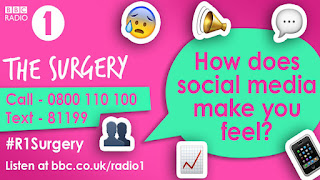Overview
– It’s a programme/podcast from BBC Radio 1
– The show replaced The Surgery in 2017 and took the Sunday Teatime slot
– The programme is hosted by Katie Thistleton and Vick Hope
– The show was previous hosted by Cel Spellman, Katie Thistleton and Radha Modgil
– The programme includes discussion of health and social issues such as exam stress, sexual health, alcohol and drugs.
– Although both The Surgery and Life Hacks ran in scheduled broadcast slots, in recent years the programme has been available as a podcast and encourages digital consumption and interaction.
Audience
– It is very interactive and inclusive through the way they use new technologies like texting in
– In the episode expressing yourself and lockdown hair disasters they talk about concepts that the listener would relate to, such as TikTok and Thomas the Tank Engine.
– The presenters themselves are both women, who are quite bubbly and differ from War of the Worlds because the presenters in War of the Worlds were males
– Vick and Katie use quite colloquial language to link to less formality such as how our generation speaks today, whereas Ward of the Worlds is more formal.
– Life Hacks use uses music and more symbolic sounds, whereas War of the Worlds is more structured and doesn’t include any music to set a serious tone about the “aliens landing”.
– The audience pleasures that are offered by Life Hacks would be Diversion, surveillance and personal relationships.
– Diversion: listening to different podcasts( reflecting what you are going through)- able to escape from what you are going through by seeking help and allowing yourself to listen to other people’s stories etc.
– The use of mainstream celebrities that the young audience will know create familiarity and the chatty tone of the presenters seem inclusive and engages the audience
How it attracts a youth audience
– Informality: the language used and the way the presenters present themselves suggest that they are trying to appeal to more of a youth audience as they tend to use informal language as if they were speaking to a friend – this also makes it more personal which may make the listeners feel as if they are being directly addressed.
– Content: the content discussed is mainly targeting a youth audience as it specifically discusses growing up and going through life from a teenager/ younger persons position (university etc)

– Emojis: the emojis suggest that this ad is aimed at more of a youth audience; stereo typically the younger generation is more accustomed to social media and would be more likely to be attracted to social media linked content
– “How does social media make you feel?” : this question directly links to social media. There is more discussion about how social media influences and affects younger audiences so this question is mainly targeting youth audiences
Life Hacks – Flashcards on the CSP
https://quizlet.com/503073012/aqa-a-level-media-life-hacks-flash-cards/
Question focus: how media has helped shaped audience theory and audience engagement through technology advancements
